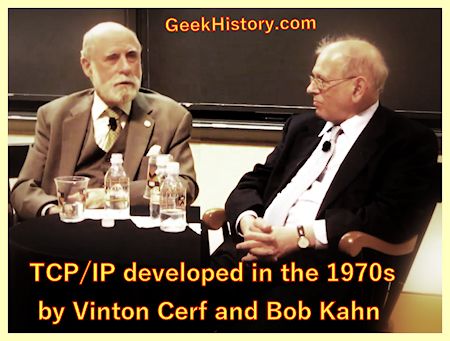 The internet was not something born of a single idea, but rather a gradual evolution, and the work of many people over many years.
The internet was not something born of a single idea, but rather a gradual evolution, and the work of many people over many years.
The idea started with a vision to create a decentralized computer network, whereby every computer was connected to each other, but if one member of the systems was hit, the others would remain unaffected.From the initial idea of a decentralized computer network came the concept of packet switching. During the 1960s Paul Baran developed the concept of packet switching networks while conducting research at the historic RAND organization.
What is a Protocol?
The network concept of protocols establishes a set of rules for each system to speak the others language in order for them to communicate. Once the concept of packet switching was developed the next stage in the evolution was to create a language that would be understood by all computer systems.
This new standard set of rules would enable different types of computers, with different hardware and software platforms, to communicate in spite of their differences. Protocols describe both the format that a message must take as well as the way in which messages are exchanged between computers.
The next phase in the evolution of the Internet would be the work of Bob Kahn and Vinton Cerf during the 1970s. Kahn and Cerf would collaborate as key members of a team to create TCP/IP, Transmission Control Protocol (TCP) and Internet Protocol (IP), the building blocks of the modern internet.
TCP/IP becomes the language of the Internet
Bob Kahn joined ARPA's Information Processing Techniques Office (IPTO) in 1972 as a program manager and initiated projects in network security, digital speech transmission, and packet radio. In the spring of 1973, Kahn approached Vinton Cerf with the idea of developing a system for interconnecting networks. Kahn and Cerf invited experts from around the world to discuss the interconnecting networks design at a seminar in June 1973. Cerf and Kahn outlined the resulting Internet architecture in May 1974, published as "A Protocol for Packet Network Intercommunication."
In 1981 the TCP/IP standards were published as RFCs 791, 792 and 793 and adopted for use. In computer network engineering, a Request for Comments (RFC) is a formal document published by the Internet Engineering Task Force (IETF) to establish Internet standards. On January 1, 1983, TCP/IP protocols became the only approved protocol on the ARPANET, the predecessor to today's internet.
Many additional members of the TCP/IP family of protocols continue to be developed, expanding of the basic principles of protocols established by Bob Kahn and Vinton Cerf back in the 1970s.
When was the Internet Born?
Some people point to September 2, 1969, the date that the first two computers communicated with each other on what would become the ARPANET. Others say the modern Internet was born on January 1, 1983 when NCP on the ARPANET was replaced by the TCP/IP protocols
